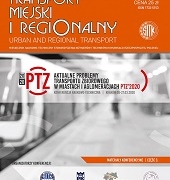Abstract 12/2018
Table of content
Martyna Waloska, Katarzyna Nosal Hoy – Walkability assessment of the Dębnicki Square area in Krakow
Waldemar Parkitny – Analysis of paid parking zones’ in Opole
Anna Górka, Jarosław Szustek – Implementation of the priority for trams on the “Zgrupowanie AK Radosław” roundabout in Warsaw using the partial intersections division method
Mariusz Szałkowski, Ryszard Wróbel – Development of electromobility in urban public transport in Krakow
Krystian Banet – The concept of improving transport accessibility and spatial linkages on the example of the university campus in Kortowo in Olsztyn
Wiesław Starowicz – Model scope of the Passenger Rights Charter in urban public transport
Abstracts
Martyna Waloska, Katarzyna Nosal Hoy
Walkability assessment of the Dębnicki Square area in Krakow
Abstract: The article presents subject of widely accessible public spaces and pedestrian traffic. It illustrates selected results of analyzes conducted in terms of walkability of the Debnicki Square area in Krakow. The multidimensionality of the issue required going beyond the generally used concepts of pedestrian traffic analysis and taking into account techniques such as inventory, survey and observation of user behavior. The results of the inventory and observation of user behavior made it possible to assess the walkability of the area in terms of usability and comfort, safety and attractiveness. Additionally the results of the survey conducted among space users provided information about their travel behavior, ways of spending free time in the area and opinions about the land development. Thanks to this broad approach, the analysis of the issue has gained a more complete context, and the proposals of activities aimed at improving the walkability of the area, formulated on its basis, not only encourage walking, but also longer stay there.
Key words: pedestrian traffic, walkability, public space, public space quality
Waldemar Parkitny
Analysis of paid parking zones’ in Opole
Abstract: Opole is one of a dozen provincial cities of medium size. Like in other cities in Poland, one can notice dynamic growth of number of passenger cars here. The large number of vehicles causes difficulties in traffic including parking problems. As a result there have been introduced zones of paid parking and car traffic restrictions. The article considers, among other, the analysis of paid parking zones’ functioning for limited periods, conditions of using car parks in a zone, sales volumes of various subscription types, numbers and receipts from the sale of parking tickets, etc.
Key words: paid parking zones, car parks, parking subscriptions, parking discounts, authorization to park
Anna Górka, Jarosław Szustek
Implementation of the priority for trams on the “Zgrupowanie AK Radosław” roundabout in Warsaw using the partial intersections division method
Abstract: Radoslaw Roundabout is one of the largest intersections in Warsaw, where 5 tram routes connect. Large volumes of pedestrians, individual vehicles and trams require an advanced traffic actuated algorithm to provide effective traffic control. The article introduces an innovative approach of the Warsaw Trams company designers to the process of designing and implementing complex traffic control algorithms. Possible effects can be obtained on the example of the implementation of the tram priority on the Radoslaw Roundabout. The publication includes a description of the algorithm generation method, the method of project implementation and the results achieved before and after the implementation of adaptive traffic control.
Key words: roundabout, actuated control algorithms, traffic lights, tram priority
Mariusz Szałkowski, Ryszard Wróbel
Development of electromobility in urban public transport in Krakow
Abstract: The article presents development of electromobility in Krakow’s public transport in the field of introducing zero-emission electric buses into operation. Actions to reduce pollution from public transport in Krakow have been presented, starting with changing regulations limiting emissions of pollutants in previously used diesel engines, through the use of hybrid drives until the introduction of electric buses to operation. The most frequently used technical solutions and the first Krakow’s experiences with electric buses and the beginnings of their regular operation were described. The actions taken to optimize the use of electric buses in work on lines have been characterized. On the basis of the current state of implementation, plans and intentions in the coming years in this area as well as threats resulting from the lack of stabilized standards as far as technical solutions are concerned have been presented.
Key words: urban transport, public transport, electromobility, electric bus
Krystian Banet
The concept of improving transport accessibility and spatial linkages on the example of the university campus in Kortowo in Olsztyn
Abstract: The first part of the paper reviews the literature on the concept of LUTI – Land Use-Transportation Interaction. In second part of the paper the tram line to the campus of the University of Warmia and Mazury in Olsztyn was analyzed. Studies on planning documents showed a lack of coherence in the provisions concerning the transport system and the development of the spatial structure, which do not allow to intensify the development in the vicinity of the transport corridor served by the tram line. In particular, it was decided to focus on the analysis of transport and spatial connections between the three functional areas of Kortowo and proposed three variants of transport service. Those variants are based on the idea of a shared space along Oczapowskiego Street and parking restrictions. Each of the variants assumes a different basic mode of transport: bus, tram and monorail.
Key words: transport accessibility, spatial planning, LUTI (Land Use Transport Interaction)
Wiesław Starowicz
Model scope of the Passenger Rights Charter in urban public transport
Abstract: The most popular form of services guarantee from other modes of transport, which is the Passenger Rights Charter, in urban public transport is not defined in Polish cities. The organizers of public transport or operators in Polish cities announce order regulations related to the transport of persons and luggage as well as the regulations of transport by means of public transport. Both in regulations and statutes, there are records about passenger rights, but they are interspersed with duties. The background to the discussion in the article is the analysis of legal conditions regarding passenger rights in the European Union. Taking into account the review of existing provisions formulating passenger rights in the transport regulations [6], the model scope of the Passenger Rights Charter in urban public transport in Poland was formulated. It can be the basis for creating individual charters in selected cities organizing urban public transport.
Key words: passenger transport, urban public transport, charter of passenger rights

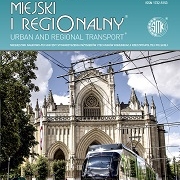 SITKRP
SITKRP 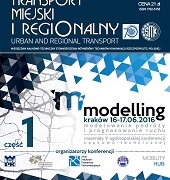 SITK RP
SITK RP 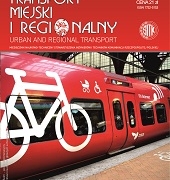 SITK RP
SITK RP 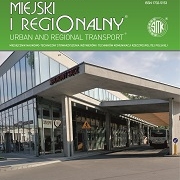 SITK
SITK 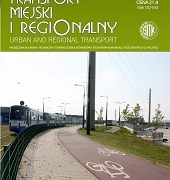 SITK RP
SITK RP 